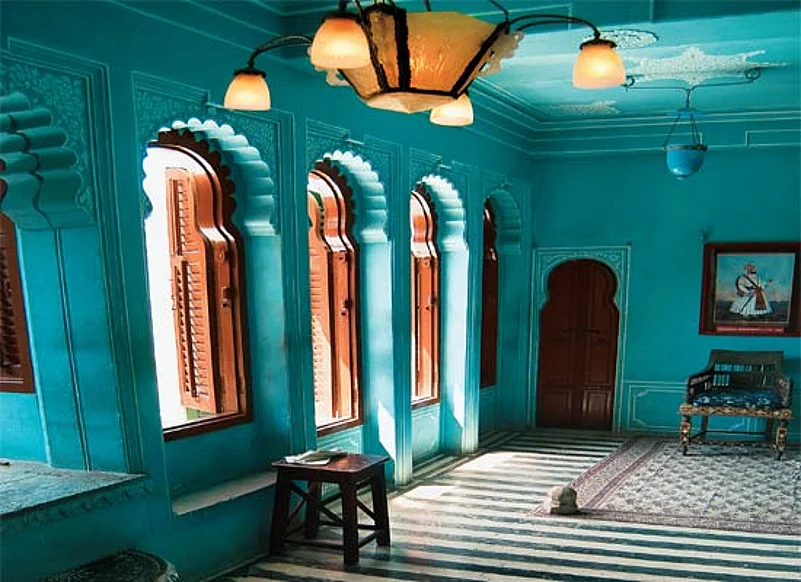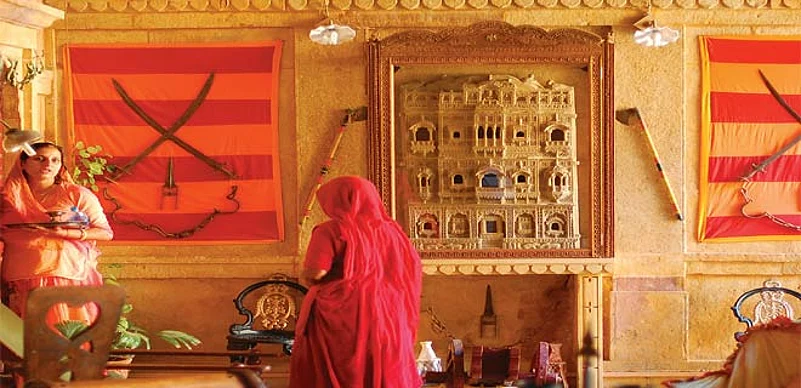My first brush with Rajasthan was the visual spectacle in Ian Fleming’s bond escapade Octopussy, which was elaborately set in Rajasthan. What stood out besides the routine bond razzmatazz was the exquisite beauty of Rajasthani palace architecture, masterly workmanship and sheer artistic audacity of our native artisans and their patrons who created these masterpieces long before the whites arrived on the scene.
So, off we went to see and live first hand this wonderland royal heritage—the high art of the Indian palace architecture in our recent road trip to Rajasthan. We made a rudimentary itinerary touching on some of the major erstwhile royal strongholds and yet wove-in some adventure by avoiding all kinds of prior bookings or detailed planning. This strategy, we thought, would help maintain flexibility and keep our focus sharply on discovering.
The first stop, after a swift early drive from Delhi, was Jaipur. Jaipur, has historically seen several settlements made at different periods in time. Raja Jai Singh, a noted Astronomer and mathematician built the most recent specimen, the Pink City—which in modern independent India has seen elevation of status to the state’s capital and resultant explosive expansion all around it. But the heritage sights, which are liberally sprinkled throughout and are easy to access, have only benefited from the expansion and easy access.
We stayed at the Samode Haveli, located at the northern gate of Jaipur—a classic example of clusterhousing (Mohalla) style of habitat, typical of North India. Samode Haveli was originally designed as an occasional makeshift residence for the royal household of Samode, a subservient fief to the Jaipur state that rose as the most powerful and richest princely state in Rajasthan ever since their original diplomatic and nuptial alliance with Akbar.
Advertisement

The Haveli, thus, exudes some very interesting characteristics. The size and stature of structures are deliberately diminutive, while the quality of workmanship is exquisite— arguably more tasteful and refined than found in other dwellings or structures in or around Jaipur. The Haveli seems to have evolved out of an original central dwelling unit and expanded in concentric circles by acquiring nearby properties in line with the expansion of size and status of the Samode royal household. A labyrinth of passageways and interesting juxtaposition of dwelling units resulted through this evolution—and this is what gives a unique character to the Haveli.
Our two days at the Haveli kept us sufficiently engaged in admiring and noting its almost never-ending discoveries and beauties. We particularly loved the dining room with the walls totally draped with beautiful and tasteful ornamental paintings and the Victorian furniture wellmatched with the character of the vaulted room. The service and food quality is top notch.
Our next stop was Pal Haveli in Jodhpur. The history of this structure goes back over 300 years when Thakur Umaid Karanji accompanied Maharaja Takhat Singh from Idar in Gujarat to Jodhpur. Thakur was awarded Pal as a fief, in lieu of his services rendered. Initially, the family resided in Palgarh, a fort built in the tiny hamlet of Pal, about 15 km from Jodhpur but soon constructed and moved to the present residence in the city. The family has lived here ever since.
Our day of arrival was the day of Dussehra festival and we had the added pleasure of observing the festival celebrated in the city square right below while enjoying a fine Rajasthani dinner served by an army of Khansamas. With the entry into the arid part of Rajasthan, the habitat building style became a bit more liberal in spacial matters while the emphasis on the decorative aspect downplayed a bit by focusing more on developing a style that combated the harsh climate better.
Since the ruling Jodhpur family could boast of lofty forts and palaces perched on the hill-top, there seemed to have been less fright for high structures here. The highlight of the complex was its Baithak and its large central compound designed to celebrate festivals and special events such as diplomatic meetings and marriages. The large water tank with its clearly visible pool of fish visible from the palace roof was another attraction that must have provided relief to the Purdah-bound ladies of the household.
Next we decided to head to Udaipur—the actual location for Bond’s Octopussy. Instead of the prohibitive Fateh Prakash Palace that Roger Moore was framed in, luck offered us Jagat Niwas, the original Subedar’s house next doors to Fateh-Prakash, and, arguably, a better specimen for exhibiting a compact and tasteful dwelling style of the high society.
True to the ‘Venice-of-east’ character of this charming city, the palace offered a romantic setting with its own integrated ghat, and spectacular views of sunrise over the adjoining Fateh Prakash Palace and sunset beyond the lake. The dazzling white-walled courtyard of the palace was a great attraction where the restaurant hosted live classical music through the lazy evenings and served the most delectable Mughlai and Rajasthani food with excellent selection of chilled beer.
Advertisement

No visit to Rajasthan is complete without experiencing the Thar desert. And, the best way to experience the Thar is by visiting Jaisalmer—the Golden Fort. We found the Nachna Haveli, the family residence of the brother of the king and now run as a guest house. This dwelling is interesting to us due to its beautiful and tasteful workmanship of the local honey-coloured and red sandstone, its vaulted construction, interesting juxtaposition of rooms, courtyards, canopied fountains with water channels, and relatively spartan yet tasteful decorations.
With its central location in the old town below the fort, the haveli also served as a great focal point for venturing out for discovering the town’s hidden gems. Jaisalmer’s buildings are exquisitely decorated with intricately carved and interchangeable (in the sort of screw-on way) sandstone ornamentation. We took a guided tour of the jewelers mohalla and witness first-hand the creation and nuances of the intricate Kundan jewellery. We also made a day trip to a desert camp and participated in night camel safari organised by our hosts.
Although we would have liked to hang around more and discover more, the pressing assignments forced us to turn back. Needless to say, this trip was one of the most memorable. Discovering the subtle and artistic beauties of this wonderful land was truly a trip to the glorious past—something 007 omitted to point his guns on.
olmdesk@outlookindia.com















 Just one email a week
Just one email a week